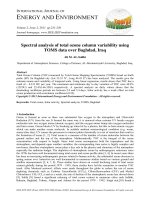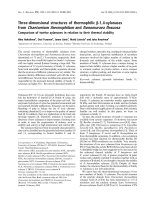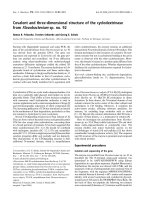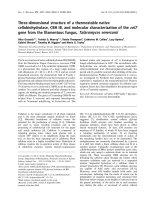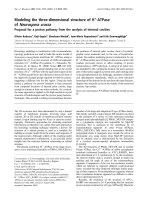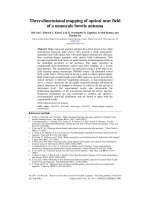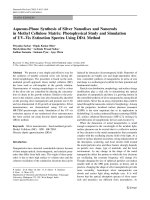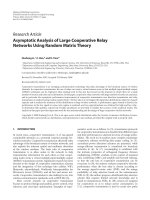Three dimensional analysis of bolted joint member stiffness using frusta method
Bạn đang xem bản rút gọn của tài liệu. Xem và tải ngay bản đầy đủ của tài liệu tại đây (1.36 MB, 13 trang )
International Journal of Mechanical Engineering and Technology (IJMET)
Volume 11, Issue 3, March 2020, pp. 55-67, Article ID: IJMET_11_03_006
Available online at />ISSN Print: 0976-6340 and ISSN Online: 0976-6359
© IAEME Publication
THREE DIMENSIONAL ANALYSIS OF BOLTED
JOINT MEMBER STIFFNESS USING FRUSTA
METHOD
Muhammad.M. Gogazeh and Hassan.A. AL Dabass
Mechanical Engineering Department, Faculty of Engineering &Technology
Philadelphia University, Amman, Jordan
ABSTRACT
Joint member stiffness has a great influence for both static and dynamic loading for
a safe mechanical design of many types of bolted- jointed member connections. A three
dimensional mathematical model for the jointed member system has been derived. This
work provides a simple mathematical technique used to calculate different types a
jointed member stiffness of a bolted connections. A finite element analysis is performed
for the bolted joint and the model is used to predict stress field for a Grey Cast iron and
aluminum alloy. Joint member stiffness is presented against member aspect ratio in
dimensionless form. Results show good agreement as compared with those of used
techniques of Montosh and Marschke
Keywords: Bolted Joint Member Stiffness.
Cite this Article: Muhammad.M. Gogazeh and Hassan.A. AL Dabass, Three
dimensional analysis of bolted joint member stiffness using frusta method, International
Journal of Mechanical Engineering and Technology 11(3), 2020, pp. 55-67.
/>
1. INTRODUCTION
In this work the bolted joint member stiffness has been studied analytically, several concepts
have been used to determine the extra components of stiffness (these steps will be discussed in
the next section). However, these steps was originally established according to the approach
and concepts of conical geometry was used by Shigley (Frusta) model [1,2] . There is another
approach called Roster’s pressure-cone model for stiffness calculations with a variable cone
angle. This method is quite complicated so we here choose a simpler method with a fixed predetermined cone angle α [3,4] .
2. MATHEMATICAL FORMULATION
2.1. Basic Concepts
The main concept of Frusta approach is that stress in the joints-member arrangements takes an
approximate conical geometry shape (See Figure 1). This conical shape helps to derive the
main governing equations based on circle and cone calculus . In general, stiffness is defined
/>
55
Muhammad.M. Gogazeh and Hassan.A. AL Dabass
as = ; Where P is the compressive load raised from holding the joint to member. And δ is the
deformation – deflection caused by this force. In this work the general form of stress
distribution between the face and the head of the bolt is assumed to take conical form as shown
in figure 1.
Figure 1 assumed conical stress distribution
2.2. Derivation of the Governing Equations
Here We will be use the basic equations corresponding circle, cone and their combination which
called frusta , here is main equations:
The well-known general form of the circle equation is in two dimensions is:
(𝑥 − 𝑎) + (𝑦 − 𝑏) = 𝑟
(1)
(𝑥 − 𝑎) + (𝑦 − 𝑏) = 𝑧
(2)
The cone equation
These are the main two equations to be used to derive the main governing equations of bolt
joint member stiffness. The fundamental equation used to determine the deformation δ is [1]:
(3)
δ=
If we took a small deflection and a small displacement of a small element, equation [3] can
be written as:
𝑑𝛿 =
(4)
𝑑𝑥
Figure 2 Circle conventions
/>
56
Three dimensional analysis of bolted joint member stiffness using frusta method
It is to be noted that the circle and cone equations can be represented as :
𝑥 +𝑦 = 𝑟
(5)
𝑥 +𝑦 = 𝑧
(6)
First we will find the joint stiffness in y- direction which is denoted as ky.
For this purpose, we will use the circle equation (Eq. 5)
Solving this equation with respect to x to obtain
(7)
𝑥 =𝑟 −𝑦
Taking the change of x with respect to y (i.e: we differentiate x with respect to y) , yields
:
(8)
2𝑥. 𝑑𝑥 = −2𝑦. 𝑑𝑦
= −
(9)
𝑑𝑥 = − 𝑑𝑦
(10)
We could write the differential form of deformation equation (Eq. 4).
Substitute the value of 𝑑𝑥 obtained above to have the 1st order differential formula of
deformation equation to be
𝑑𝛿 = −
(11)
𝑑𝑦
Note that, x here will be treated as a constant (horizontal distance along the width of the
plates starting from centreline of the bolt). To find the value of the deformation δ, we should
do single integral to solve the 1st order differential equation above.
For this purpose, we should define the following conventions first:
The cone angle α: Whose value remains fixed from the definition of this approach.
( let α = 30°).
The plate thickness t: And it is used as the end limit the integral over z-axis , integral
limits.
The bolt radius R: is the nominal value of the bolt radius .
After we got the conventions cleared, we should solve Eq. 11 to find deformation, so we
can relate it to stiffness by using Equation 3.
𝛿=∫ −
(12)
𝑑𝑦
Here the variable of integration is y. And we can make an additional presence of y in the
integration above by defining the term area [1]
(13)
𝐴 = 𝜋(𝑟 − 𝑟 )
=𝜋
𝑧 tan 𝛼 +
(14)
−
And by setting 𝛼 = 30°
𝐴=𝜋
0.5774𝑧 +
(15)
−
So Eq. 12 becomes
/>
57
Muhammad.M. Gogazeh and Hassan.A. AL Dabass
𝛿=−
𝛿=− ∫
(16)
𝑑𝑦
∫
.
.
Using the basic concepts of calculus and
equation as :
𝛿=
(17)
.
integration , we can represent deformation
(18)
𝑙𝑛
Where K is constant and it was set to simplify algebraic operations, and 𝐾 = 0.334𝑧 𝑥𝜋 +
1.155𝑧𝑥 𝜋 +
Now we can find stiffness k from the general equation 𝑘 =
as
(19)
𝑘 =
Now we find the stiffness in the direction of z (kz) :
For this purpose, we will be using the cone equation (Eq. 6)
We solve this equation with respect to x so we obtain
(20)
𝑥 =𝑧 −𝑦
As we exactly did with stiffness on y, we do same thing here with z
(21)
2𝑥 𝑑𝑥 = 2𝑧 𝑑𝑧
(22)
=
(23)
𝑑𝑥 = 𝑑𝑧
Let us recall the differential form of deformation equation (Eq. 4) and substitute dx as found
in Eq. 23 in Eq 4 to find
𝑑𝛿 =
(24)
𝑑𝑧
As we did earlier, we can solve Eq. 24 as a separable differential equation as
𝛿=∫
(25)
𝑑𝑧
Here, the variable of integration is z and it can be present in the integration by defining the
term area as we last defined it
𝐴=𝜋
0.5774𝑧 +
−
So Eq. 25 becomes
𝛿= ∫
.
(26)
.
The solution of the integral is
𝛿=
0.334𝑥𝜋 +
.
(27)
𝑥 𝜋𝑙𝑛|0.334𝑧 𝑥𝜋 + 1.555𝑧𝑥 𝜋|
We can see that after substituting the limits of integration, it is an improper integration
where we can find some values after substituting t minus infinite ∞ so the answer will be zero.
/>
58
Three dimensional analysis of bolted joint member stiffness using frusta method
Hence stiffness on this axis does not have a physical meaning. This is due to that this axis (z)
is containing a region that is not included between the two plates.
So we can only find stiffness ky with x and z as two dimensional values to be substituted in
Eq. 19.
Now, we will use Eq. 19 to generate data curves to represent how stiffness varies with the
position coordinates x, and z.
We will also show a simulation study trying to show how stress distributes in the members
(plates) for some samples of materials.
3. RESULTS AND DISCUSSION
Now we will present a few resulted charts after applying Eq. 19 on some samples of geometries
that are made of variety if materials. All the details will be shown separately for each sample.
We will also include a simulation study.
3.1. Case1: single plate analysis
Grey Cast Iron plate, 10 mm hole diameter for bolt entrance at multiple fixed z coordinates as
shown in Figure 4
Figure 4 Geometric properties of the sample (250x12x90)
We will study the stiffness here for this sample as single. Using Eq. 19, we generated the
following data curves:
/>
59
Muhammad.M. Gogazeh and Hassan.A. AL Dabass
ky vs x
ky (kN/m)
60000
50000
40000
30000
20000
10000
0
0
0.01
0.02
0.03
x (m)
0.04
0.05
The shown graphs are for z = 0 cm, 1 cm, 2 cm, 3 cm, 4 cm, and 5 cm, respectively for Grey
Cast Iron sample. For better visualization, we may put these data curves into a single chart as
Figure 5 Combined results found on Figure a, b, c, d, e, and f for Grey Cast Iron sample
/>
60
Three dimensional analysis of bolted joint member stiffness using frusta method
We can see the relation is linear and the difference between each value of z is the interval
of applying the calculations.
Now we will present a simulation study for the same sample but with applying a pre-load P
of 70 N to see how stress distributes within the plate.
See Figure 6.
Figure 6 Stress distribution within the plate for Gray Cast Iron sample under the application of preload of 70 N
It can be noted that how stress distributes in the shape of a conic, which this is the basic
assumption on which the approach of Frustum by which stiffness equations are derived.
For a second case, Aluminium Alloy 1060-H12 plate, 10 mm hole diameter for bolt entrance at
multiple fixed z coordinates is used in the presented analysis (see Figure 4).
ky (kN/m)
35000000
ky vs x for multiple z values
z = 0 cm
z = 1 cm
30000000
z = 2 cm
25000000
z = 3 cm
20000000
z = 4 cm
z = 5 cm
15000000
10000000
5000000
0
0
0.02
0.04
0.06
0.08
x (m)
Figure 7 Stiffness VS. x for Aluminum Alloy 1060-H12 sample
/>
61
Muhammad.M. Gogazeh and Hassan.A. AL Dabass
Now we will show how stress distribute within this sample plate for applying a pre-load P
of 70 N. See Figure 8. As seen from figure 8, the same behavior we obtained from the previous
sample is still the same but with larger values.
Figure 8 Stress distribution within the plate for Aluminum Alloy 1060-H12 sample under the
application of pre-load of 70 N
3.2. Case2: Two joined cast iron plates analysis
Now we may do the same simulation study but for two plates placed together and these
plates will be given ductile and brittle one as follows:
Brittle-Brittle joint (Grey Cast Iron-Grey Cast Iron)
Ductile-Ductile joint (Aluminium Alloy 1060-H12- Aluminium Alloy 1060-H12)
Brittle-Ductile joint (Grey Cast Iron- Aluminium Alloy 1060-H12)
Grey Cast Iron-Grey Cast Iron joint, 10 mm hole diameter for bolt entrance (see Figure 9).
Each plate has the same dimensions as the one shown in Figure 4.
Figure 9 Grey Cast Iron-Grey Cast Iron joint, 10 mm hole diameter for bolt entrance
By applying a pre-load of 70 N, we can find the stress distribution within these plates as
shown in figure 10
/>
62
Three dimensional analysis of bolted joint member stiffness using frusta method
Figure 10 Stress distribution within Grey Cast Iron-Grey Cast Iron joint plates under the application
of pre-load of 70 N
3.3. Case 3: Two joined Aluminium Alloy plates analysis
In this case, Aluminium Alloy 1060-H12- Aluminium Alloy 1060-H12 joint, 10 mm hole
diameter for bolt entrance as shown in Figure 11 is used for analysis purpose. Each plate has
the same dimensions as ones shown in Figure 4.
Figure 11Aluminium Alloy 1060-H12- Aluminium Alloy 1060-H12 joint, 10 mm hole diameter for
bolt entrance
After applying a pre-load of 70 N, the stress distribution within these plates is found as
shown in Figure 12.
/>
63
Muhammad.M. Gogazeh and Hassan.A. AL Dabass
Figure 12 Stress distribution within Aluminium Alloy 1060-H12- Aluminium Alloy 1060-H12 joint
plates under the application of pre-load of 70 N
3.4. Case 4: cast iron and aluminium joined plates
In this case, a Grey Cast Iron and Aluminium Alloy 1060-H12 plates are joined by 10 mm hole
diameter bolt as shown in see Figure 13. As the previous cases, the plates have the same
dimensions as the one shown in Figure 4.
Figure 13 Grey Cast Iron- Aluminium Alloy 1060-H12 joint, 10 mm hole diameter for bolt entrance
When a pre-load of 70 N is applied to the problem, the stress distribution within these plates
is found and shown in Figure 14.
/>
64
Three dimensional analysis of bolted joint member stiffness using frusta method
Figure 14 Grey Cast Iron- Aluminium Alloy 1060-H12 joint plates under the application of pre-load
of 70
It should be noted that, these simulation studies were done using SolidWorks Simulation®.
The bolt is made of Aluminium Alloy 1060 and its standard were:
For single plate, we used Formed hex screw, B18.2.3.2M - Formed hex screw, M10 x
1.5 x 20 --20WN
For two-plated joint, we used B18.2.3.2M - Formed hex screw, M10 x 1.5 x 30 --30WN
4. CONCLUSION
It was shown how stiffness varies with distance along the width of the plate linearly. And this
behaviour confirms the validity of using Hook's law to relate stiffness to deformation.
Using simulation solutions, it is shown how stress distributed within the member plate
which in turn confirmed the validity of the frustum approach to predict stiffness.
These results were obtained under the assumption that the members’ material is the same
(i.e.: homogeneous ) having same modulus of elasticity E .
Otherwise, these components can be applied for non-homogeneous members having
number of n as several springs in series:
1
1
1
1
1
=
+
+
+ ⋯+
𝑘
𝑘1 𝑘2 𝑘3
𝑘
REFERENCE
[1]
[2]
[3]
[4]
Guang Zhao , Zhilang Xiong , Xin Jin , Loong Hou and Wendong Gao , Prediction of
contact stiffness in bolted interface with natural frequency experiment and finite element
analysis ,J.Tribology International , Vol .127 , Nov.2018 .PP.157-164.
Z. X. Wang , Y.Q.Wang ,G.X.Zhang ,Y.J.Shi , test and parametric analysis of aluminium
alloy bolted joints of different material types . J. Construction and building materials , Vol
.185, 2018 PP589-599.
R.M.Hizam , Allan .C.Manalo ,Warna Karunasena,Yu Bui ,effect of bolt threads on the
double lap joint strength of pultruded fibre reinforced polymer composite material , J.
Construction and Building Materials , Vol 181, 2018 ,PP185-198.
T. Yang, S.H. Fan, C.S. Lin , Joint stiffness identification using FRF measurements
Comput Struct, 81 (2003), pp. 2549-2556
/>
65
Muhammad.M. Gogazeh and Hassan.A. AL Dabass
[5]
[6]
[7]
[8]
[9]
[10]
[11]
[12]
[13]
Y. Song, C.J. Hartwigsen, D.M. McFarland, et al.Simulation of dynamics of beam
structures with bolted joints using adjusted Iwan beam elements J Sound Vib, 273
(2004), pp. 249-276
E.F. Crawley, A.C. Aubert . Identification of nonlinear structural elements by forcestate mapping Am Inst Aeronaut Astronaut J, 24 (1986), pp. 155-162
H. Ouyang, M.J. Oldfield, J.E. Mottershead . Experimental and theoretical studies of a
bolted joint excited by a torsional dynamic load Int J Mech Sci, 48 (2006), pp. 14471455
H. Ahmadian, H. Jalali .Generic element formulation for modelling bolted joints Mech
Syst Signal Process, 21 (5) (2007), pp. 2318-2334
J. Cunha, E. Foltête, N. Bouhaddi, Evaluation of stiffness of semi-rigid joints in
pultruded profiles from dynamic and static data by using model updating technique
Eng Struct, 30 (4) (2008), pp. 1024-1036
Wang, P. Sas . A method for identifying parameters of mechanical joints, American
society of mechanical engineers J Appl Mech, 57 (1990), pp. 337-342
Y. Ren, T.M. Lim, M.K. Lim . Identification of properties of nonlinear joints using
dynamic
test dataJ Vib Acoust, 120 (1998), pp. 324-330
F. Huda, I. Kajiwara, N. Hosoya, S. Kawamura . Bolt loosening analysis and diagnosis by
non-contact laser excitation vibration tests Mech Syst Signal Process, 40 (2013), pp. 589604
I. Kajiwara, D. Miyamoto, et al. . Loose bolt detection by high frequency vibration
measurement with non-contact laser excitation J Syst Des Dynam, 5 (8) (2011), pp.
1559-1571
NOMENCLATURE
k: bolt Stiffness (N/m)
ky: Stiffness on y –direction (N/m)
kz: Stiffness on z- direction (N/m)
x: 1st Circle and conic coordinate
y: 2nd Circle and conic coordinate
P: Pre-load force (N)
δ: Deflection or deformation (m)
a: Circle canter 1st coordinate
b: Circle canter 2nd coordinate
A: Conical shape area (m2)
E: Young modulus of elasticity (MPa)
r: Radius of the circle used in conical model
ro: Outside radius of the hole (m)
ri: Inside radius of the hole (m)
z: Elevation of the conic model
K: Constant to simplify integration
/>
66
Three dimensional analysis of bolted joint member stiffness using frusta method
LIST OF FIGURES
No.
1
2
3
4
5
6
7
8
9
10
11
12
13
14
Figure Caption
The assumed conical distribution of stress
Circle conventions
Deflection Conventions and definitions
Geometric properties of the sample (250x12x90)mm
Combined results found on Figure a, b, c, d, e, and f for Grey Cast Iron sample
Stress distribution within the plate for Gray Cast Iron sample under the application of pre-load
of 70 N
Stiffness VS – x dimension for Aluminum Alloy 1060-H12 sample
Stress distribution within the plate for Aluminum Alloy 1060-H12 sample under the application
of pre-load of 70 N
Grey Cast Iron-Grey Cast Iron joint, 10 mm hole diameter for bolt entrance
Stress distribution within Grey Cast Iron joint plates under the application of pre-load of 70 N
Aluminium Alloy 1060-H12- Aluminium Alloy 1060-H12 joint, 10 mm hole diameter for bolt
entrance
Stress distribution within Aluminium Alloy 1060-H12- Aluminium Alloy 1060-H12 joint plates
under the application of pre-load of 70 N
Grey Cast Iron- Aluminium Alloy 1060-H12 joint, 10 mm hole diameter for bolt entrance
Grey Cast Iron- Aluminium Alloy 1060-H12 joint plates under the application of pre-load of
70N .
/>
67
